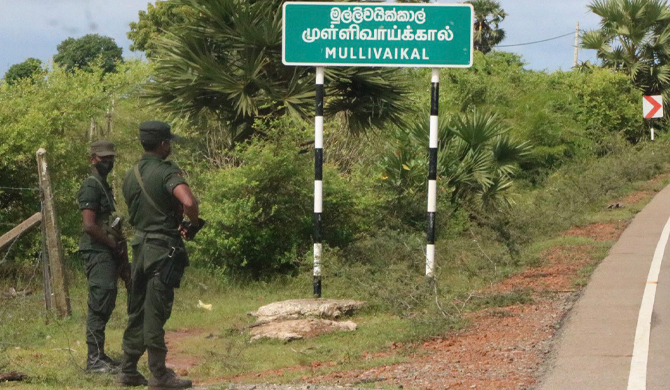Hundreds of Sri Lanka ex-soldiers recruited by multiple teams were dying in their hundreds in the killing fields of the Russia-Ukraine border amid drone warfare, according to a fighter who escaped the region.
Over 200 Sri Lankan ex-soldiers are believed to have died and a similar number are being treated in hospitals in regions like Donetsk, he said in an interview broadcast by Sri Lanka’s Derana Television.
The retired soldier said he went to Russia after paying 1.6 million to recruiting team made up of retired senior military officers who said they were to be ‘camp helpers’ providing support services
The kingpin behind the recruitment operation appeared to be an Indian national named Ramesh, he said. They were also received in Russia by a Tamil speaker, he said.
Sri Lankans who arrived on tourist visas and were then asked to sign a contract in Russian language for the ‘Wagnet’ (sic) mercenary group supervised by an Indian lady who appeared to be a lawyer who assured them that it was a one-year camp helper contract.
Escalating Recruitment Op
He and 33 other Sri Lankans were then taken to a training camp in Rostov where they underwent a 14-day course. There were about 70 Sri Lankans in the training camp at the time he was there/.
He had learned that around 600 to 700 Sri Lankan may have been taken to Russia over the past few months, most of them in the past three months.
About 200 to 300 are believed to have died and a similar number are in hospitals in areas like Donetsk, he said.
There were a larger number of mercenaries from countries like Cuba.
The recruitment process had gathered pace in the last three months, after only 3 or 4 were believed to have been recruited each month last year, he said.
Daily 10 to 15 tourist visas were being issued in Colombo, he said. The passports came back with the stamped visa within a week and they were dispatched to Russia in the next two days.
Sri Lanka’s Foreign Minister Ali Sabry told reports Wednesday that there was no official count of citizens fighting for Russia or Ukraine, but attempts were being made to help them.
“We don’t know,” Minister Sabry told reporters. “None of them go through formal or official channels.
“So your guess is as good as mine.
“We are trying to see what we can do wherever possible. We can deal with the government of any other country. We are being asked to deal with a mercenary group which is not a formal government. It’s a very difficult task.”
Cash Extraction
The soldier said he had to pay 1.6 million rupees to his recruiters while sending ex-soldier to almost certain death, he learned from fellow Sri Lankans that other recruitment teams charged less.
Some had been charged 350,000 rupees, while others were charged 1 million. It was not clear whether other recruiters told the ex-soldiers that they would have to go to the frontlines.
When his group protested that they were hired as camp helpers and refused to take up active duty the Russian officials had said they had to go to the frontlines as a one year contract had been signed.
At the mercenary camp he was told that recruiters were paid the equivalent of 2.5 million Sri Lanka rupees for each person sent to Russia.
They were then broken up into three teams and sent to the frontlines.
His group was shifted around four camps where he encountered Sri Lankan soldiers who also showed him dog tags from dead colleagues. Families back home were apparently not informed of their death, he said.
At the frontline, the Russian soldiers or mercenaries were high on drug ice, apparently to maintain their fighting spirit and Sri Lankans were not in a position to refuse to go to battle any longer for fear of being shot out of hand, he said.
Drone Fodder
That night they were ordered to take over a Ukrainian ammunition dump but he refused to go without knowing about the terrain. After his insistence, he was taken to a signals room where terrain was shown to him through a drone camera.
Asked about possible risks to guard against he was informed that there were only drones and snipers and not to worry.
As soon as they stepped out of the bunker, five Ukrainian drones hit them and one Sri Lankan was hit as they jumped back in.
The fallen Sri Lankan was heard screaming and groaning in pain but no one helped him. He then went out with another Sri Lankan colleague under drone fire and dragged the wounded Sri Lankan back into the bunder. He learned later that the wounded person was in hospital.
They were then pushed out of the bunker and told to take the ammo dump. They entered the ammunition going through open ground under drone fire, where one person died and a Pakistani was wounded.
Killing Fields
They gave him what first aid as they could with the medical kits they had and also injections that they had to relieve his pain.
After four days they were asked to return and leave one soldier with the Pakistani fighter. An older Sri Lankan fighter who was also slightly wounded elected to stay with him.
After they returned to the Russian bunker braving drones, they were sent 1.5 kilometers back from the frontline to rest and were told to return for a second operation in the night. They were fed and kept under armed guard.
The Sri Lankan ex-soldier and two others then escaped in the night while going to the toilet by distracting the sentry. He later learned that his two friends were captured.
The Russian used drones to track escapees and re-capture them. He however lay low and later managed to escape to Moscow with the help of Russian and Ukrainians in the Donetsk region and contact the Sri Lankan embassy.
He said he decided to speak out to stop others from falling into the same trap. Sri Lankans were also fighting for Ukraine, he said.





